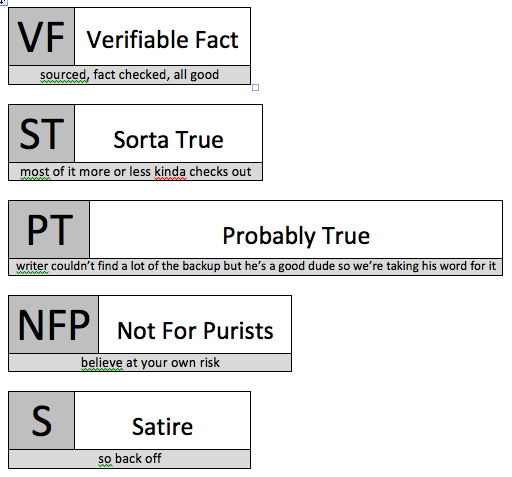It’s been a volatile few months for ethics in storytelling, what with the unprecedented “This American Life” retraction of monologist Mike Daisey’s Apple story, and with the unfurled furor over John D’Agata’s anti-accuracy screed in The Lifespan of a Fact. Of all the reactions to the Daisey fiasco, a couple stood out. Steve Myers and Craig Silverman, of Poynter, praised the “TAL” retraction’s depth while pointing out that the stunning hourlong exploration of what went wrong omitted any actual insight into the program’s standard editorial process. Myers and Silverman then went further than most analysts by posing nine public questions for the producers, including whether they plan to “bring performers and others into journalistic stories” in the future. (So far, no response.)
The Atlantic’s James Fallows, meanwhile, lamented that Daisey deceived not only a massive, presumably trusting audience but also threatened the credibility of the Western press and the efforts of human rights workers. And, he wrote, none of it had to happen: “If he had even once said that he was presenting a polemic, a metaphor, a dramatization, an ‘inspired by real events’ monologue rather than real ‘facts,’ no one could ever have complained.”
The conversation resurfaced this week with new questions about humorist David Sedaris’ essays, which have appeared on NPR and in the New Yorker. A Washington Post story probed the “gray area” of Sedaris’ work, raising “the question of what’s permissible in the context of a nonfiction program.” Paul Farhi wrote: “The immediate question is whether Sedaris’ stories are, strictly speaking, true − an important consideration for journalistic organizations such as NPR and programs such as This American Life. A secondary consideration is what, if any, kind of disclosure such programs owe their listeners when broadcasting Sedaris’ brand of humor.”
So what’re we talking about here, a story-rating system?
We seem to be pinwheeling toward that moment when publications and programs build windows into process for the sake of preempting attacks on credibility. In the meantime let’s keep talking about it, tedious though the topic may seem. (If the topic doesn’t seem tedious, congratulations − you are a narrative nerd!) How are you framing your storytelling? What decisions have you made about your methods? Are you, say, generally more comfortable putting reconstructed dialogue in italics or behind em dashes than in direct quotes, or in some cases are you so confident in your sourcing that you’ll use the sacred punctuation? Do you prefer to qualify some remembered or reconstructed actions with “perhaps” rather than state them as fact? How much of the reporting and writing process will you address in your About This Story box or your back-of-the-book notes? To what degree will you be transparent with readers? To what extent will you go to be transparent? If your publisher refuses to run the sourcing with the story, or at length in the back of your book, will you create a companion website or another online space and run it yourself? Don’t know how to do that? Here, watch: Tom Lake practically line-by-lines his marvelous Atlanta magazine story “The Last Heavy Footfalls of Doc Hullender.”
Even with a high degree of transparency, there may be questions. Now that trust is fluid, it must be guarded and earned and re-earned, even if you are a god. When Hampton Sides wrote the bestseller Hellhound on His Trail: The Stalking of Martin Luther King Jr. and the International Hunt for His Assassin, the New Yorker’s David Grann wrote, in a review: “Hampton Sides has long been one of the great narrative nonfiction writers of our time, excavating essential pieces of American history − from the daring rescue of POWs during World War II to the settling of the West − and bringing them vividly to life.” (Takeaway: Sides is highly regarded by one of the most acclaimed narrative journalists in the business.)
In a Q-and-A, Sides was asked, “The ‘Notes’ and ‘Bibliography’ sections ... total more than 50 pages − how did you begin to tackle the wealth of information? What was your research process like?” Sides answered, in part: “I don’t think I unearthed any massive bombshells that will change the world forever − like, say, proving once and for all that J. Edgar Hoover actually orchestrated the whole affair. Instead, what I unearthed were thousands and thousands of tiny details that make the story come alive on the page and make it possible, for the first time, to understand the tragedy as a complete, multi-stranded narrative. The book’s packed full of novelistic detail − weather, architecture, what people were wearing, what the landscape looked like, the music that was playing on the radio. To get all this stuff, I had to do the usual sort of archival work − from the LBJ Presidential Library in Austin to the London newspaper archives − and I went pretty much everywhere James Earl Ray went, following in his fugitive footsteps: Puerto Vallarta, Toronto, Los Angeles, Atlanta, Birmingham, Lisbon, London.” (Takeaway: Sides sourced his material extensively, and to the satisfaction of esteemed peers.)
The New York Times gave Sides’ book a great review but for one line: “Beyond writing that ‘the kitchen was redolent with the tang of yeast,’ Mr. Sides goes mercifully easy on the made-up particulars, preferring to take a cool, clinical view of Galt and his subsequent travels.”
“Made-up particulars” − is this characterization fair? Did the reviewer carelessly damn the book’s (and therefore the writer’s) integrity with that one line? Or did the author undermine himself with his description of baked goods?
Here is the paragraph in question:
“How could I know this?” Sides later told an audience at the Mayborn literary nonfiction conference in Texas. “Well, the prison bakers at the Missouri state pen interviewed after Ray’s escape said they expressly liked to work in the bakery because it smelled so good in there ... and only minutes before Ray’s escape, they had just pulled 65 loaves of bread from the oven.”
A leap? No, the writer decided. In this case, he allowed logic to prevail. Had the bakers used yeast in the bread? Yes. Does baked bread have a fragrance? Yes. Since the bakers just moments earlier had pulled the fresh bread from the ovens and placed it on the racks, was it safe to assume the kitchen smelled of baked bread?
Risking absurdity, let’s push it: What if the bakers burned the bread that morning − not so redolent a kitchen then, was it? What if, by accident, they forgot to add the yeast? Or, referring to the first line of the paragraph, what if these particular bakers lacked sweat glands and therefore did not in fact glisten by the light of the ovens? Possible! But highly unlikely. The question for the narrative writer becomes where to lay bets − on the possible or the not likely? − or whether to gamble at all. Would it have been just as effective to say the bakers had just taken 65 loaves of fresh-baked bread from the oven and let readers fill in the rest with their senses?
Nearly a decade ago, we published a lengthy essay that paved this slippery slope better than anything we’d seen. We re-read it the other day, to see if it holds. It does. “... There should be a firm line, not a fuzzy one, between fiction and nonfiction and all work that purports to be nonfiction should strive to achieve the standards of the most truthful journalism,” wrote Roy Peter Clark. He suggested adhering to two principles:
So, how to do it? When to do it? Whether to do it? This is about to get interesting.
The Atlantic’s James Fallows, meanwhile, lamented that Daisey deceived not only a massive, presumably trusting audience but also threatened the credibility of the Western press and the efforts of human rights workers. And, he wrote, none of it had to happen: “If he had even once said that he was presenting a polemic, a metaphor, a dramatization, an ‘inspired by real events’ monologue rather than real ‘facts,’ no one could ever have complained.”
The conversation resurfaced this week with new questions about humorist David Sedaris’ essays, which have appeared on NPR and in the New Yorker. A Washington Post story probed the “gray area” of Sedaris’ work, raising “the question of what’s permissible in the context of a nonfiction program.” Paul Farhi wrote: “The immediate question is whether Sedaris’ stories are, strictly speaking, true − an important consideration for journalistic organizations such as NPR and programs such as This American Life. A secondary consideration is what, if any, kind of disclosure such programs owe their listeners when broadcasting Sedaris’ brand of humor.”
So what’re we talking about here, a story-rating system?
We seem to be pinwheeling toward that moment when publications and programs build windows into process for the sake of preempting attacks on credibility. In the meantime let’s keep talking about it, tedious though the topic may seem. (If the topic doesn’t seem tedious, congratulations − you are a narrative nerd!) How are you framing your storytelling? What decisions have you made about your methods? Are you, say, generally more comfortable putting reconstructed dialogue in italics or behind em dashes than in direct quotes, or in some cases are you so confident in your sourcing that you’ll use the sacred punctuation? Do you prefer to qualify some remembered or reconstructed actions with “perhaps” rather than state them as fact? How much of the reporting and writing process will you address in your About This Story box or your back-of-the-book notes? To what degree will you be transparent with readers? To what extent will you go to be transparent? If your publisher refuses to run the sourcing with the story, or at length in the back of your book, will you create a companion website or another online space and run it yourself? Don’t know how to do that? Here, watch: Tom Lake practically line-by-lines his marvelous Atlanta magazine story “The Last Heavy Footfalls of Doc Hullender.”
Even with a high degree of transparency, there may be questions. Now that trust is fluid, it must be guarded and earned and re-earned, even if you are a god. When Hampton Sides wrote the bestseller Hellhound on His Trail: The Stalking of Martin Luther King Jr. and the International Hunt for His Assassin, the New Yorker’s David Grann wrote, in a review: “Hampton Sides has long been one of the great narrative nonfiction writers of our time, excavating essential pieces of American history − from the daring rescue of POWs during World War II to the settling of the West − and bringing them vividly to life.” (Takeaway: Sides is highly regarded by one of the most acclaimed narrative journalists in the business.)
In a Q-and-A, Sides was asked, “The ‘Notes’ and ‘Bibliography’ sections ... total more than 50 pages − how did you begin to tackle the wealth of information? What was your research process like?” Sides answered, in part: “I don’t think I unearthed any massive bombshells that will change the world forever − like, say, proving once and for all that J. Edgar Hoover actually orchestrated the whole affair. Instead, what I unearthed were thousands and thousands of tiny details that make the story come alive on the page and make it possible, for the first time, to understand the tragedy as a complete, multi-stranded narrative. The book’s packed full of novelistic detail − weather, architecture, what people were wearing, what the landscape looked like, the music that was playing on the radio. To get all this stuff, I had to do the usual sort of archival work − from the LBJ Presidential Library in Austin to the London newspaper archives − and I went pretty much everywhere James Earl Ray went, following in his fugitive footsteps: Puerto Vallarta, Toronto, Los Angeles, Atlanta, Birmingham, Lisbon, London.” (Takeaway: Sides sourced his material extensively, and to the satisfaction of esteemed peers.)
The New York Times gave Sides’ book a great review but for one line: “Beyond writing that ‘the kitchen was redolent with the tang of yeast,’ Mr. Sides goes mercifully easy on the made-up particulars, preferring to take a cool, clinical view of Galt and his subsequent travels.”
“Made-up particulars” − is this characterization fair? Did the reviewer carelessly damn the book’s (and therefore the writer’s) integrity with that one line? Or did the author undermine himself with his description of baked goods?
Here is the paragraph in question:
The prison bakers sweated in the glare of the ovens, making bread for the hungry men of the honor farm. Since dawn, they’d prepared more than sixty loaves, and now the kitchen was redolent with the tang of yeast as the fresh bread cooled on the racks before slicing. A guard, armed but not very vigilant, patrolled the galley perimeter.
“How could I know this?” Sides later told an audience at the Mayborn literary nonfiction conference in Texas. “Well, the prison bakers at the Missouri state pen interviewed after Ray’s escape said they expressly liked to work in the bakery because it smelled so good in there ... and only minutes before Ray’s escape, they had just pulled 65 loaves of bread from the oven.”
A leap? No, the writer decided. In this case, he allowed logic to prevail. Had the bakers used yeast in the bread? Yes. Does baked bread have a fragrance? Yes. Since the bakers just moments earlier had pulled the fresh bread from the ovens and placed it on the racks, was it safe to assume the kitchen smelled of baked bread?
Risking absurdity, let’s push it: What if the bakers burned the bread that morning − not so redolent a kitchen then, was it? What if, by accident, they forgot to add the yeast? Or, referring to the first line of the paragraph, what if these particular bakers lacked sweat glands and therefore did not in fact glisten by the light of the ovens? Possible! But highly unlikely. The question for the narrative writer becomes where to lay bets − on the possible or the not likely? − or whether to gamble at all. Would it have been just as effective to say the bakers had just taken 65 loaves of fresh-baked bread from the oven and let readers fill in the rest with their senses?
Nearly a decade ago, we published a lengthy essay that paved this slippery slope better than anything we’d seen. We re-read it the other day, to see if it holds. It does. “... There should be a firm line, not a fuzzy one, between fiction and nonfiction and all work that purports to be nonfiction should strive to achieve the standards of the most truthful journalism,” wrote Roy Peter Clark. He suggested adhering to two principles:
Do not add. This means that writers of nonfiction should not add to a report things that did not happen. To make news clear and comprehensible, it is often necessary to subtract or condense. Done without care or responsibility, even such subtraction can distort. We cross a more definite line into fiction, however, when we invent or add facts or images or sounds that were not there.
Do not deceive. This means that journalists should never mislead the public in reproducing events. The implied contract of all nonfiction is binding: The way it is represented here is, to the best of our knowledge, the way it happened. Anything that intentionally or unintentionally fools the audience violates that contract and the core purpose of journalism – to get at the truth. Thus, any exception to the implied contract – even a work of humor or satire – should be transparent or disclosed.
So, how to do it? When to do it? Whether to do it? This is about to get interesting.



